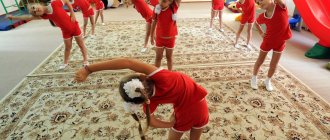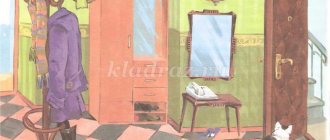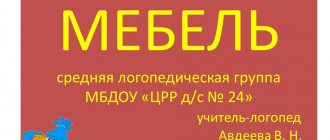Summary of direct educational activities (DED) in the senior group on the topic: “Family traditions.” Author: preschool teacher Nazarova Galina Aleksandrovna.
Program content:
- Give children an idea of old family traditions.
- Improve the dialogical form of speech, the ability to coherently present events from personal experience.
- Improve the ability to construct complex sentences using the expression “because” to connect their parts.
- Enrich children's active vocabulary (nouns: amulet, tradition; adjectives: ancient, painted).
- Strengthen the ability to highlight the main differences in plot pictures and justify your answer in an explanatory speech.
- Develop the ability to establish associative connections and make basic inferences.
- Introduce the possibility of drawing decorative elements in an unconventional way (with a pen): a wavy line, a leaf, a dot. Develop a sense of rhythm, color, symmetry.
- To awaken respect and interest in the traditions of the Russian people.
Materials and equipment:
rebus, multimedia board, tape recorder, audio recordings of Russian folk music; coal, grains, coins, towel; salt dough preparations “Obereg”; feathers, palettes with red, yellow, green gouache; jars of water; wet wipes, loaf, towel, hoop, object pictures.
Progress of the lesson.
Educator:
— Guys, today I received a letter by email from children from Finland. They wrote that they were creating a book “Traditions of the Peoples of the World.” But here’s the problem: they know nothing about Russian traditions. Shall we help?
— The letter contained an assignment. Guess what's encrypted here?
— What traditions do Finnish children want to learn about? (about family traditions).
- What is family? (children's answers).
- Name your family members? And you? (children’s detailed answers following the example of the teacher: “My family is my husband Georgy, sons Alexander and Roman, daughter Marina and I - Galina Aleksandrovna).
- Look at these pictures carefully.
— What is shown in the paintings? (family)
— Tell me, how do these families differ from each other? (with leading questions, the teacher helps to deduce the children’s answers to the concepts of “modern family”, “ancient family”).
— Why did you decide that this is a modern family? (children’s answers and reasoning)
- Why do you think that this is a family that lived in the old days? (children’s answers and reasoning)
Proverbs about family.
Educator:
— One proverb says: “A family in a heap is not scary even a cloud.” How do you understand it? (children's reasoning).
“And they also say: “A good family is strong in tradition.”
What do you think traditions are? (children's answers).
Educator:
Tradition is the rules accepted in the family that both adults and children follow: for example, how to spend a family holiday or vacation. Every family has its own family rules and traditions.
— What family traditions do you have in your family? (children's answers).
The teacher invites the children to the table with subject pictures.
- Shows a picture of “Bread and Salt”.
- What tradition associated with bread and salt existed in Rus'? (children's answers)
The teacher brings out a loaf of bread with a salt shaker and treats the children. Says:
— Previously, guests were greeted with bread and salt, bowed at the waist, showing their respect. The guest broke off a small piece of bread, dipped it in salt and ate.
The teacher shows a picture of a cat.
— What was the tradition associated with cats in Rus', has anyone guessed? (children's answers)
— Yes, there is such an old tradition: when moving to a new house or apartment, let the cat be the first to enter the home. People believed that the cat protected and protected the house.
Shows a picture of a baby.
— What could be a tradition in Rus' associated with a child?
- This is very interesting: when the child was bathed for the first time, a coal, a grain, a coin was placed in a basin of water. For what? Try to guess? (children's answers).
Educator:
By lowering objects into the water they said sentences.
— Coal — May the house always be warm.
- Grain - Always be full.
— Coin — Be always rich.
The teacher invites the children to put objects into the basin.
Shows a picture of a holiday.
— I think you will recognize this tradition immediately. (children's answers).
— There were many holidays in Rus'.
— What did you do during the holidays? (sang, played, danced, danced in circles). I propose to play an interesting Russian folk game “Cockfight”.
Game "Cockfight"
Children stand in pairs inside the hoop, hands behind their backs. Jumping on one leg should force the opponent out of the circle.
Educator:
“And during the holidays, people played various musical instruments that they made with their own hands.
Playing musical instruments.
The teacher invites the children to the table with musical instruments.
— Choose your instrument. Come to me (the teacher arranges the children).
— You are an ensemble of Russian folk instruments, and I am your leader. We will play Russian folk instruments. But in order for us to get a beautiful melody, we need to look at the leader and follow the following rules.
- When I point to the back row, the children are playing on spoons, when I point to you guys, you start playing, but the children with spoons do not play. But when I wave both hands, we begin to play together. If I make a circle in the air, the game is over. The rules are clear.
The teacher invites the children to the table with cards.
- I have a very interesting task for you.
— There are cards on the table, choose a card and come up with your own family tradition. But make sure that this item is in your tradition.
Creative task
Children inventing family traditions.
Productive activity
- And guys, before there was a talisman in every house - in the form of a horseshoe. (the teacher shows the children on the interactive board a talisman - a horseshoe).
— It was believed that a horseshoe brings happiness and prosperity to the house. Even now some families have such a talisman.
The teacher offers to sit at the table. Shows a sample of the amulet (blanks made from salted text) and offers to paint the horseshoe.
— I propose to decorate your amulets - horseshoes for good luck in your home.
Previously, there were no pencils or brushes. What did people draw with? (children's answers).
The teacher says that in the old days there were no pens. They wrote and drew with a feather from the tail or wing of a rooster. With a pen you can draw wavy lines, leaves, and dots.
Productive activity. Help, encouragement for children, individual work.
Summarizing
—Which tradition do you remember most? Why?
— What traditions will we write about to Finnish children?
“I will send this horseshoe to Finland as a gift to the children, and you can hang your horseshoes above the front door at home so that there is happiness and kindness in your home.”
- And remember, guys, and at home say, “A good family is strong in tradition.”
Author: Nazarova Galina Aleksandrovna - teacher of the first qualification category
0




